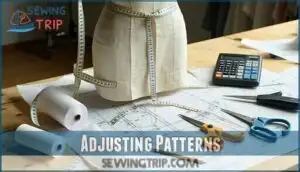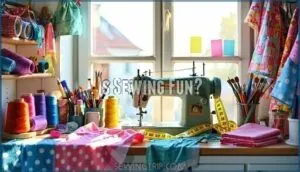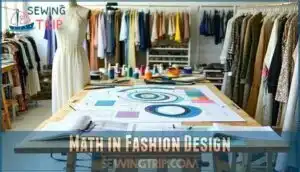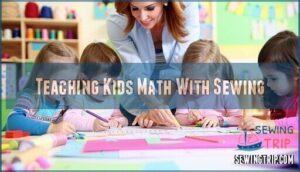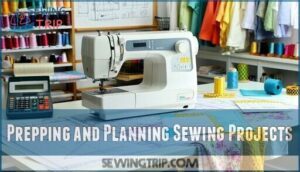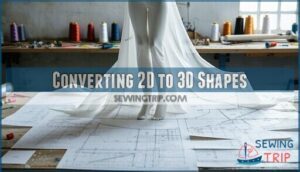This site is supported by our readers. We may earn a commission, at no cost to you, if you purchase through links.
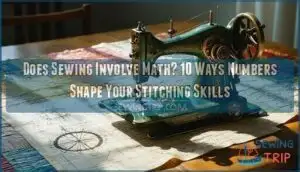 Every time you pick up fabric scissors, you’re actually doing math without realizing it.
Every time you pick up fabric scissors, you’re actually doing math without realizing it.
When you measure seam allowances, calculate fabric yardage, or work with pattern pieces, you’re using fractions, geometry, and spatial reasoning.
Think about it – converting a flat pattern into a 3D garment requires understanding angles, proportions, and measurements.
You’ll add, subtract, and multiply when figuring out how much material you need.
Even simple tasks like hemming pants involve calculating lengths and ensuring straight lines.
It’s like being a math wizard with thread and needles, turning numbers into wearable art through clever calculations and precise measurements.
Table Of Contents
Key Takeaways
- You’re using math constantly when sewing – from measuring seam allowances in fractions like 1/2 inch to calculating fabric yardage and working with geometric shapes to create 3D garments from flat patterns.
- Pattern adjustments require mathematical problem-solving skills as you’ll divide measurements, subtract excess fabric, and use ratios to achieve the perfect fit for your body measurements.
- Sewing develops your spatial reasoning abilities by transforming 2D pattern pieces into 3D garments, teaching you to visualize how flat fabric will wrap around curves and angles of the human body.
- You don’t need to be a math expert to sew successfully – the basic arithmetic, fractions, and geometry involved become second nature through hands-on practice, making math concepts tangible and enjoyable rather than abstract.
Sewing Uses Math
You’re already using math every time you pick up a needle and thread, even if you don’t realize it.
From measuring seam allowances in fractions like 1/2 inch to calculating how much fabric you’ll need for that new dress, sewing puts your number skills to work in surprisingly practical ways.
Fractions
Fractions are the backbone of sewing math. You’ll measure seam allowances in quarters and eighths, calculate fabric width ratios, and mark fractional measurements on patterns.
Every stitch you make is a fraction in action—turning mathematical precision into wearable art.
Adjusting measurements for different fabrics becomes natural as you visualize how pieces fit together perfectly.
- Master quarter-inch seam allowances for professional-looking garments
- Calculate fabric width ratios to determine yardage needs accurately
- Mark precise fractional measurements on pattern pieces for perfect fit
- Adjust measurements smoothly when switching between fabric types
- Visualize how fractional pieces create your finished garment masterpiece
Geometry
Beyond fractions, sewing geometry transforms flat fabric into stunning 3D garments.
You’ll create geometric shapes like circular yokes and angular collars while mastering sewing angles through pattern geometry.
Spatial visualization helps you envision how pieces connect before cutting.
Right angles guarantee crisp corners, while curves add flowing lines.
This sewing math makes geometry tangible and fun, using spatial visualization to enhance the design process.
Measuring Fabric
Calculating fabric yardage might seem intimidating, but it’s actually straightforward once you break it down. You’ll need to master a few key measurements to avoid running short on material or buying way too much.
Start by understanding your fabric width – most quilting cotton runs 44-45 inches wide, while apparel fabrics often measure 58-60 inches. This affects your yardage calculations substantially. Always add seam allowance to your pattern pieces before measuring. For most garments, that’s typically 5/8 inch around each edge.
To guarantee a proper fit, remember to retake measurements regularly, especially if your body shape changes. Here’s your fabric measurement game plan:
- Measure each pattern piece including seam allowances
- Consider grain direction when planning your pattern layout
- Calculate total yardage by dividing piece length by fabric width
Remember the golden rule: measure twice, cut once. Your sewing measurements determine project success, so take your time with these calculations.
Adjusting Patterns
Pattern adjustments are where sewing meets problem-solving. You’re basically becoming a garment detective, using math to crack the code of perfect fit.
Start by comparing your body measurements to the pattern’s finished dimensions. If your waist measures 28 inches but the pattern’s designed for 32, you’ll need to remove 4 inches total—that’s 2 inches from each side seam. Simple division keeps everything balanced.
Here’s your adjustment roadmap:
| Measurement Issue | Math Solution | Result |
|---|---|---|
| Too wide waist | Subtract excess ÷ 2 per side | Customized fit |
| Short torso | Remove length evenly | Proper proportions |
| Narrow shoulders | Add width ÷ 2 per side | Comfortable movement |
| Long sleeves | Subtract excess length | Perfect sleeve length |
Creating fitting muslins before cutting your good fabric saves both money and heartache. These test garments let you perfect your pattern alterations through trial and error. Mastering these skills often involves specialized alteration tools for precision. Pattern grading and design customization become second nature once you master the basic math behind altering patterns.
Drafting Patterns
Once you’ve mastered adjusting existing patterns, you’re ready to create your own pattern blueprints from scratch. Custom templates give you complete creative freedom – no more settling for "close enough" fits.
Pattern making math becomes your best friend here. You’ll sketch shapes, calculate angles, and mark precise measurements. Start with basic blocks like bodices and sleeves. Measure key points, then use geometric principles to connect them with perpendicular lines and triangles. Your drafting tools – ruler, pencil, and paper – transform ideas into reality.
Sewing pattern drafting teaches valuable skills beyond stitching:
- Spatial reasoning that makes you think like an architect
- Technical drawing skills that impress everyone
- Problem-solving abilities that boost confidence
Pattern alterations become second nature when you understand the foundation. To begin, most pattern makers start with basic patterns called slopers.
Is Sewing Fun?
You might think all those measurements and calculations would make sewing feel like homework, but here’s the thing – it’s actually a blast.
Just like cooking, once you get the hang of mixing numbers with creativity, you’ll find yourself having way more fun than you expected, and it becomes a truly creative experience.
Enjoyable Hobby
Sewing transforms math from boring classroom theory into your favorite creative outlet.
You’re not just crunching numbers—you’re building a fulfilling hobby that doubles as stress relief after tough days.
Each project becomes personal expression mixed with skill development that grows stronger with every seam.
The sewing community welcomes beginners who struggle with fractions just as warmly as experts who draft complex patterns.
Problem-solving becomes second nature when you’re chasing your creative vision.
Math stops feeling like work when you’re creating something beautiful with your hands.
It’s surprisingly addictive once you start.
Many beginners start with simple sewing projects.
Like Cooking
Just like in the kitchen, sewing transforms raw materials into something wonderful through careful Recipe Conversion and precise measurements.
When you’re following a dress pattern, you’re basically using a recipe that requires Kitchen Math to succeed. You’ll calculate Ingredient Amounts of fabric, convert measurements between inches and centimeters, and work with fractions when adjusting seam allowances.
Following Instructions becomes second nature as you measure twice and cut once. Need a smaller size? Creative Substitutions come into play as you modify patterns using ratios and arithmetic.
Both cooking and sewing demand attention to detail – mess up the measurements, and your soufflé falls or your sleeves don’t fit. The satisfaction of creating something beautiful with your hands makes all that math worthwhile.
Sewing can also provide mental health benefits, offering relaxation and a sense of accomplishment.
Math in Fashion Design
Fashion designers crunch numbers all day long, but it’s way more exciting than it sounds!
You’ll use Design Ratios to balance proportions and create stunning silhouettes. Pattern Grading helps you scale designs across different sizes while maintaining perfect fit.
Textile Geometry comes into play when calculating fabric layouts and minimizing waste.
Cost Estimation keeps your budget in check, and Proportion Analysis guarantees your garments look balanced on different body types.
Math in fashion design isn’t just about calculations—it’s about transforming creative visions into wearable art through precise measurements and strategic planning.
Designers also use math to tackle real-world design scenarios.
Spatial Skills in Sewing
While fashion designers sketch beautiful concepts, your brain works overtime turning those flat drawings into real clothes. Spatial reasoning transforms sewing from guesswork into precision craftsmanship.
Your mind constantly performs 3D Visualization when you look at pattern pieces and imagine how they’ll wrap around a body. Think of it like mental origami – you’re folding flat paper into complex shapes before you even touch fabric.
Shape Recognition helps you identify which pattern piece creates sleeves versus bodice sections. Spatial visualization kicks in when you’re figuring out how a curved seam will lay against someone’s shoulder.
Here’s how spatial skills work in practice:
- Visualizing 2D to 3D transformation when laying out patterns
- Understanding Pattern Manipulation for fit adjustments
- Planning Garment Construction sequence and assembly
- Using geometry to calculate angles and curves
Your brain becomes a 3D modeling program, rotating pieces mentally and predicting how they’ll fit together. Spatial reasoning turns flat fabric into fitted garments that actually work on real bodies.
Teaching Kids Math With Sewing
Kids learn math best when they’re having fun, and sewing delivers that perfectly.
You’ll watch them master Fraction Fundamentals by measuring quarter-inch seam allowances and half-yard fabric pieces.
Geometric Garments like circular skirts teach shapes while building spatial reasoning skills.
Pattern Calculations become exciting puzzles rather than boring worksheets.
STEM Sewing transforms abstract concepts into tangible creations.
Teaching math through sewing works because children see immediate results.
Child-friendly materials and simple projects build confidence.
Math education becomes a hands-on adventure when you combine numbers with needle and thread, making Geometric Garments and using Pattern Calculations to create something tangible.
Prepping and Planning Sewing Projects
Behind every successful sewing project lies careful math-based planning that transforms creative vision into reality.
Your project timeline depends on accurate calculations – measuring fabric requirements, estimating construction hours, and scheduling fitting sessions.
Budgeting fabric becomes a mathematical puzzle where you’ll calculate yardage, account for pattern repeats, and add extra for mistakes.
Smart sewers always perform a skill assessment before diving in, honestly evaluating whether their abilities match the project’s complexity.
Design inspiration flows better when you understand the numbers behind it.
Material sourcing requires comparing fabric widths, calculating costs per yard, and determining if your budget aligns with your dreams.
Sewing pattern adjustments demand precise measurements and mathematical conversions.
Fabric cutting math guarantees you don’t run short halfway through construction.
Think of project prep like recipe planning – you wouldn’t start cooking without checking ingredients first.
This mathematical groundwork prevents those "oops" moments that make you want to throw fabric across the room!
Converting 2D to 3D Shapes
When you’re staring at flat pattern pieces, it’s hard to imagine they’ll become a fitted blazer or flowing dress.
This Shape Transformation is where sewing gets really exciting.
Your brain works overtime with spatial reasoning, turning 2D shapes into stunning 3D garments through clever Pattern Draping techniques.
Think of it like origami with fabric.
You’re using mathematical principles to create Volume Creation through darts, pleats, and curved seams.
Each fold and stitch involves Form Manipulation that transforms flat material into something with depth and structure.
Your Dimensionality Skills grow stronger with every project.
You’ll start seeing how a simple rectangle becomes a sleeve, or how strategic cutting creates the perfect neckline curve.
Geometry in sewing isn’t just theory – it’s the magic that makes clothes actually fit bodies.
With practice, this mental gymnastics becomes second nature.
You’ll confidently visualize how patterns will look before you even cut the fabric.
Frequently Asked Questions (FAQs)
Does sewing teach math?
Like threading a needle with precision, you’ll discover that sewing absolutely teaches math through hands-on practice.
You’re calculating measurements, working with fractions, solving geometry puzzles, and mastering spatial reasoning while creating beautiful garments.
Do you need math to sew a pattern?
You’ll need basic math skills to follow sewing patterns successfully. Measuring seam allowances, calculating fabric amounts, and adjusting pattern pieces all require fractions and simple arithmetic to achieve professional-looking results.
How does math affect sewing?
Math’s your invisible sewing partner, quietly calculating every stitch.
You’ll use fractions for seam allowances, geometry for pattern layouts, and measurements for perfect fits.
Without math, you’d be guessing your way through crooked hems and poorly fitted garments, which is why math is essential.
Do you match math with sewing?
You’re constantly using fractions for seam allowances, geometry for pattern pieces, and calculations for fabric yardage. Every measurement, adjustment, and layout becomes a mini math problem you’ll solve naturally.
Do you need a math expert to sew?
You don’t need a math expert to sew.
Basic skills like measuring, adding fractions, and calculating fabric amounts are enough.
Most sewing math involves simple arithmetic that anyone can learn with practice.
Why should you learn sewing?
Learning to sew gives you practical life skills, saves money on alterations, boosts creativity, and builds confidence.
You’ll develop problem-solving abilities, patience, and precision while creating unique pieces that express your personal style perfectly.
How is math used in sewing?
Picture cutting fabric for a dress – you’ll calculate 5 yards needed, measure 5/8-inch seam allowances, and adjust pattern pieces using fractions.
You’re constantly adding, subtracting, and working with geometry to create perfectly fitted garments.
Is sewing a hard skill?
You’ll find sewing’s definitely a hard skill that takes practice to master.
There’s measuring, cutting, following patterns, and troubleshooting when things go wrong.
But don’t worry—everyone starts somewhere and improves with time.
Is math involved in fashion?
Math meets fashion in fantastic ways!
You’ll calculate fabric amounts, adjust pattern measurements, and use geometry for perfect fits.
From determining seam allowances to creating precise curves, mathematical skills make your designs shine brilliantly.
How is math used in being a singer?
You’ll use math constantly as a singer – counting beats, understanding time signatures, calculating tempo changes, and measuring vocal ranges.
Math helps you stay in rhythm, harmonize properly, and even manage your career finances effectively, which involves calculating tempo changes and other musical elements.
Conclusion
Surprisingly, the very scissors you’ve grown comfortable with have been your math teacher all along.
When someone asks "does sewing involve math," you can confidently say yes – it’s everywhere in your craft.
From calculating yardage to adjusting pattern pieces, you’re constantly using mathematical concepts.
You’ve mastered fractions through seam allowances and geometry through garment construction.
So next time you thread your needle, remember you’re not just creating beautiful pieces – you’re solving equations with every stitch.

